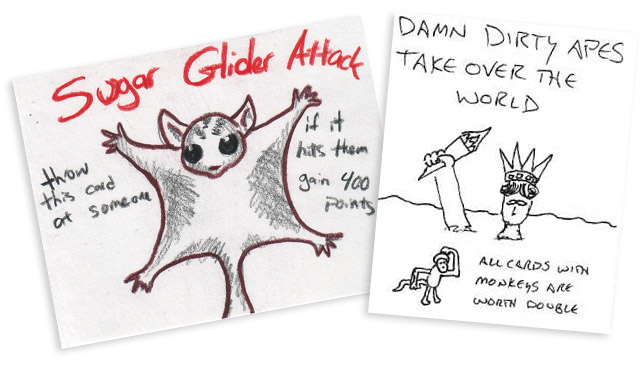Ah, the holiday season. 'Tis the season for family, feasting and parties. 'Tis also the black hole of gaming. As holiday schedules fill up, maintaining a regular tabletop gaming routine becomes more and more difficult. Many groups find the prospect of holiday game scheduling too daunting a task to overcome. They choose to risk the dreaded "hiatus" slumbering through to hopefully reawaken in the new year. My group has been fortunate in the three years we have been together. We have never needed to put things on hold during the holidays. This year, however, our schedule is rougher than usual. We have postponed and skipped several game sessions, and I must admit my scheduling nerves are becoming a bit frayed.
A couple weeks ago, we were faced with a last-minute player shortage and the question of how to proceed. Rather than calling off the game for the night, I decided to scratch an itch I had been having to indulge in some collaborative world-building using 1000 Blank White Cards (1KBWC). If you are unfamiliar with
1KBWC, let me bring you up to speed. The game is born of the same imaginative strain as blanket forts and broomstick ponies--the comandeering of utilitarian objects for the purpose of imaginitive play.
The basic 1KBWC game begins with a box of ordinary, blank index cards. Players jot down items, scenarios and other imaginings and then assign them a point value from -100 to +100 and/or make up a rule associated with the card. Examples:
- Party Foul! You spill your drink on your cards! -20 points and discard your most valuable card.
- Baby-sized Burrito +40 points
Card contents are created on the spot before play begins and are only limited by the imaginations of the players. The cards are then dealt and played around the table with each player playing a card on either themselves or on another player... because players gonna play. The objective is to end the game with the most points.
Well, Matthew Neagley over at Gnome Stew has written a couple posts on his use of the
1KBWC format for collaborative world building. This variant of the game begins as the players of a tabletop gaming group jot down things they would like to encounter in their ideal game world. These can be treasures, villains, fantastic locations or anything else that pops into mind. The best ideas are usually simple and not terribly specific. Complexity and specificity come as the game progresses.
Once the cards are written, shuffled and dealt, play proceeds as in the standard game, except that the cards are played on the table rather than against particular players. Cards can either be laid down on their own or used to build on a card already in play. As the game proceeds, the clusters of cards develop into potential plot seeds and adventure locations. If you like, their placement on the table may also serve as a rough geographical orientation within the game world. My particular group chose to ignore the spatial component, but came up with some amazing ideas that may very well appear in future adventures.
Some example clusters include:
Cluster A:
- underwater fortress built into the side of an undersea volcano
- lizardmen cult
- mechanical plesiosaur submarine
- sentient coral
- the kraken
Cluster B:
- golden colossus
- lava lake
- trees made of fire
- rebel group of good-aligned devil warriors
- hammer of the gods
The exact associations within each cluster are ultimately up to the GM to flesh out, but both of the examples above could easily be expanded into an adventure.
Playing 1KBWC was an excellent alternative to canceling a player-short game night, and I encourage my fellow GMs to give it a try. Our group had a lot of fun watching these cards coalesce into the birth-goo of adventure, and I do not doubt that I will catch excited glimmers of recognition if and when the ideas we generated work their way into my game.





